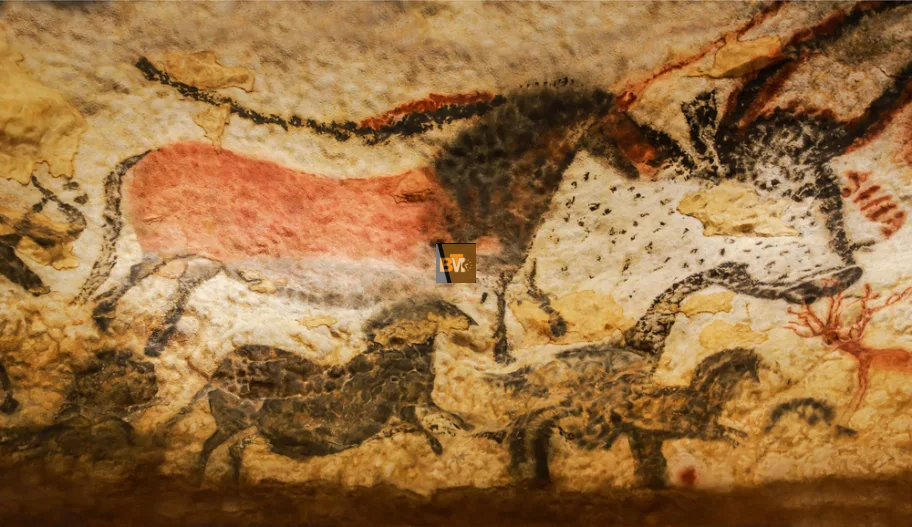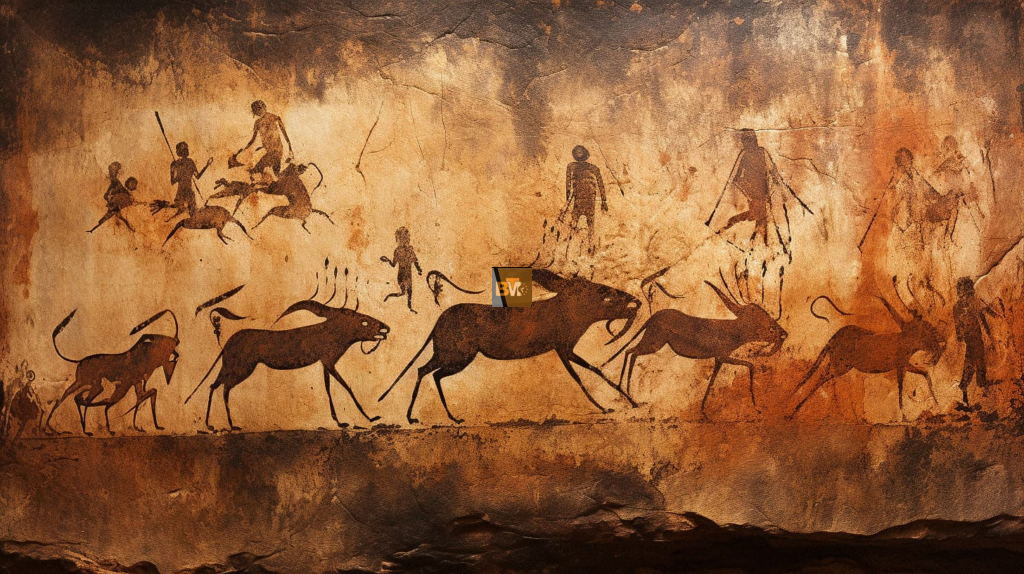Cave paintings, also known as rock art, are one of the oldest forms of human expression. These ancient artworks were created on the walls of caves by early humans. Dating back thousands of years, these paintings provide us with a glimpse into the lives and beliefs of our ancestors. Most cave paintings were created using natural pigments found in the environment and depict animals, humans, and various symbols. They serve as a fascinating window into prehistoric times and remain a subject of study and admiration today.
Why Did Early Humans Create Cave Paintings?
Cave paintings have puzzled researchers for centuries. One key question is: Why did early humans feel the need to create these artworks?
Many experts believe that early humans painted on cave walls for spiritual or religious purposes. The images may have been part of rituals to ensure successful hunts, fertility, or protection from danger. Animals, often depicted in cave paintings, were critical to the survival of early humans. By painting these creatures, early humans might have believed they were invoking some kind of control over them.
Another theory is that cave paintings served as a way to communicate. Without written language, early humans may have used images to tell stories, record events, or share important information. These visual stories helped them pass down knowledge and cultural practices through generations.
Regardless of their exact purpose, cave paintings reflect the creativity and intelligence of early humans and their desire to leave a lasting mark on the world.
Where Can You Find Famous Cave Paintings?
Famous cave paintings can be found in various locations across the world, particularly in Europe, Africa, and Asia. These sites attract researchers, tourists, and art enthusiasts alike, eager to see firsthand the remarkable works of early humans. Some of the most notable cave painting sites include:
- Lascaux Cave in France: Known for its vivid and detailed depictions of large animals.
- Altamira Cave in Spain: Features some of the most well-preserved prehistoric art.
- Chauvet Cave in France Houses some of the oldest known cave paintings in the world, dating back over 30,000 years.
- Cueva de las Manos in Argentina: Famous for its many stenciled handprints, this cave offers a unique glimpse into early South American cultures.
Each of these locations holds its own significance and provides important insights into the cultural and artistic practices of early human civilizations.
Lascaux Cave Paintings: France’s Hidden Treasures
One of the most renowned examples of prehistoric cave art is found in the Lascaux Cave in southwestern France. Discovered in 1940 by a group of teenagers, the cave contains over 600 paintings and 1,500 engravings that date back approximately 17,000 years. These images primarily depict large animals, including horses, deer, bison, and even felines. What makes Lascaux particularly remarkable is the vibrant colors and intricate details that have been preserved over thousands of years.

Experts believe that these paintings may have been part of religious ceremonies or hunting rituals. The cave is often referred to as the “Sistine Chapel of Prehistory” due to its impressive scale and the skill of its ancient artists. Sadly, Lascaux has been closed to the public to protect the fragile artwork from further deterioration, but a replica site, Lascaux II, allows visitors to experience the beauty of these ancient paintings without risking damage to the originals.
Altamira: Spain’s Artistic Cave
Altamira Cave, located in northern Spain, is another famous site of prehistoric art. Known for its breathtaking depictions of bison, Altamira’s paintings are renowned for their use of color and shading, techniques that demonstrate the advanced skills of its creators. Discovered in 1868, the paintings are estimated to be around 36,000 years old.
The cave also contains images of horses, deer, and human hands, which add to the rich tapestry of art found within its walls. Altamira is considered one of the most important prehistoric art sites in the world and provides crucial insights into the life and culture of early humans.
Chauvet Cave: Oldest Known Cave Paintings
The Chauvet Cave, located in southern France, is home to some of the oldest known cave paintings, with artwork dating back over 30,000 years. The paintings primarily depict animals such as lions, rhinoceroses, and bears, and the sheer number of species represented is astonishing.
The artists of Chauvet used a technique that involved shading and creating a sense of movement, something quite sophisticated for the time. These paintings offer a rare glimpse into the natural world as seen by prehistoric humans and are a testament to their artistic capabilities.
What Do Cave Paintings Teach Us About Early Humans?
Cave paintings provide valuable insights into the daily lives, beliefs, and environments of early humans. Through these images, we learn about the animals they hunted, the rituals they performed, and the spiritual beliefs they may have held. The frequent depiction of animals suggests a close connection between early humans and the natural world, highlighting the importance of animals in their survival.
Furthermore, cave paintings show us that early humans were not just focused on survival but also had a strong desire to express themselves creatively. This creativity marks an important milestone in the development of human culture and suggests that our ancestors had a sophisticated understanding of their world.
How Were Cave Paintings Made?
Creating cave paintings was no easy task for early humans. Without modern tools and materials, they had to rely on their resourcefulness to bring their artistic visions to life. Many of the paintings were created using a combination of natural pigments, brushes, and even their hands.
Early humans often used the walls and ceilings of caves as their canvas, carefully selecting areas with smooth surfaces. They may have applied pigments with their fingers, sticks, or brushes made from animal hair or plant fibers. Some paintings were created by blowing pigment through hollow bones to create a spray effect, while others involved etching designs directly into the rock with sharp tools.
These innovative techniques allowed early humans to create detailed and vibrant images that have survived for thousands of years, offering a lasting legacy of their artistic achievements.
What Materials Did Early Artists Use?
The materials used by early cave artists were all derived from their natural environment. To create their paintings, they relied on a variety of pigments, which they sourced from minerals, plants, and other natural materials. Some of the most common materials used include:
- Charcoal: Burnt wood was often used to create black pigment for outlining figures or adding depth to the images.
- Ochre: A naturally occurring clay pigment that comes in shades of yellow, red, and brown, ochre was commonly used to create vibrant colors in cave art.
- Hematite: This iron oxide mineral produces a deep red color and was another popular pigment for prehistoric artists.
By using these natural materials, early humans were able to create long-lasting and visually striking images that still captivate us today.
Natural Pigments Used in Cave Art
Natural pigments played a crucial role in the creation of cave paintings, and early humans were skilled at extracting and applying them to their artwork. Here are some of the most common pigments used in cave art:

- Red Ochre: This pigment, rich in iron, produced a deep red or orange hue and was widely used in prehistoric art. Red ochre was often ground into a fine powder and mixed with animal fat or water to create paint.
- Yellow Ochre: Similar to red ochre, yellow ochre was derived from clay and provided a bright, earthy yellow color that added variety to the cave paintings.
- Manganese Oxide: This mineral produced black or dark brown pigments, which were frequently used for outlining figures or adding contrast to the images.
- White Kaolin Clay: Early artists also used white clay to create lighter shades and highlights in their paintings.
These pigments, combined with the creativity of early humans, helped to bring the walls of caves to life with vivid and expressive artwork.
Tools Early Humans Used for Cave Paintings
In addition to pigments, early humans used a variety of tools to create their cave paintings. Some of these tools include:
- Brushes: Made from animal hair or plant fibers, brushes allowed early artists to apply pigment in precise lines and detailed strokes.
- Hands: In many cases, artists simply used their hands to apply pigment directly onto the cave walls. Handprints and stenciled outlines of hands are common motifs in prehistoric art.
- Blowing Tubes: Hollow bones or reeds were used to blow powdered pigment onto the walls, creating a soft, spray-like effect.
- Engraving Tools: Sharp stones or bones were used to carve designs into the rock, either as stand-alone engravings or as details in larger paintings.
These tools demonstrate the ingenuity of early humans and their ability to work with the materials available to them.
Why Are Cave Paintings Important Today?
Cave paintings are important for several reasons. First, they provide a direct connection to our ancestors and offer a glimpse into the lives and cultures of prehistoric humans. These artworks serve as one of the earliest forms of communication, showing that early humans were not only concerned with survival but also with expressing themselves creatively.
In addition, cave paintings are valuable sources of information for scientists and researchers. They help us understand the development of human cognition, culture, and artistic expression. By studying cave art, we can gain insights into how early humans viewed the world around them and how they interacted with their environment.
Finally, cave paintings remind us of the enduring power of art and its ability to transcend time and space. Even though these paintings were created thousands of years ago, they continue to inspire and fascinate people today.
How Can We Preserve Cave Paintings for the Future?
Preserving cave paintings for future generations is a challenge due to the fragile nature of these ancient artworks. Over time, cave paintings have been exposed to natural elements, such as humidity, temperature fluctuations, and erosion, which can cause the pigments to fade or deteriorate.
To protect these precious works, many cave sites have been closed to the public, with replicas or virtual tours being offered instead. Additionally, conservation efforts involve monitoring the conditions inside caves, controlling moisture levels, and using specialized techniques to repair or stabilize damaged areas.
By taking these steps, we can help ensure that future generations will be able to appreciate and learn from the remarkable art of our distant ancestors.
Where Can You Find Famous Cave Paintings?
Famous cave paintings can be found in various locations across the world, particularly in Europe, Africa, and Asia. These sites attract researchers, tourists, and art enthusiasts alike, eager to see firsthand the remarkable works of early humans. Some of the most notable cave painting sites include:
- Lascaux Cave in France
- Altamira Cave in Spain
- Chauvet Cave in France
The Bottom Line
Cave paintings are much more than simple drawings on walls. They are a testament to the creativity, intelligence, and spiritual beliefs of early humans. These ancient artworks give us insight into their lives, their environment, and their connection to the world around them. As we continue to study and preserve these incredible paintings, we gain a deeper understanding of our shared human history and the role that art has played in shaping civilization. Whether for religious, cultural, or artistic purposes, cave paintings remain a powerful symbol of humanity’s desire to leave a lasting mark on the world.







Leave a Reply